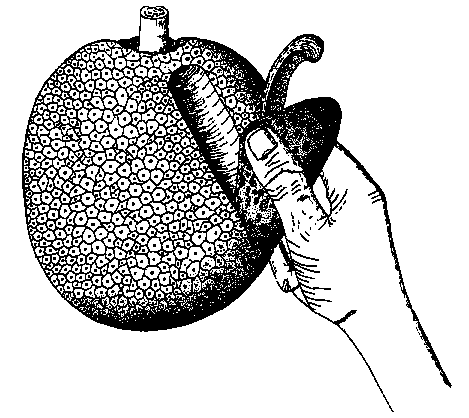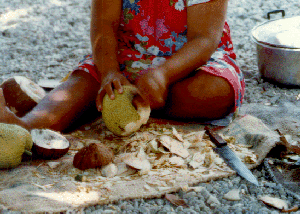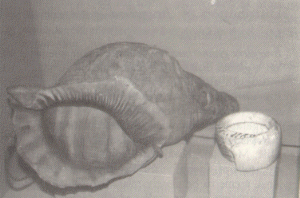

|
Essays on the Marshallese Past
Breadfruit Peelers old technology but still high tech |
The traditional material culture in the Marshall Islands has come under heavy pressure. Many western items and products have replaced the traditional ones, in some cases even if the western ones are inferior or economically less sound.
One tool is an exception: the breadfruit peeler or
The peeler, which can be made from a clean shell in about 15-20 minutes, takes just a much rind off the breadfruit as needed, but not too much. Thus, not only is it easy to use and non-corroding in the harsh climate, it is also the most economical tool, far superior to western iron knifes.
The tool set of the prehistoric and pre-European Marshallese was limited by the raw material available on the atolls. They comprised wood and leaves, shells, corals, fish, bird bones and human bones and teeth.

Marshallese Breadfruit Peeler (Libbukwe in kabwiro) seen from the top (left), bottom (middle) and the side (right)
The raw material for the scrapers are either tiger cowries (Cypraea tigris) or their close allies in size and ornamentation, Mauritian cowries (Cypraea mauritiana) which are amongst the most popular shells of the tropics and adorn mantlepieces worldwide. Cypraea tigris has a distribution throughout the Indo-Pacific region. The molluscs feed mainly on sponges but also browse on other tiny animals and plants. Their habitat is predominantly sandy patches between rocks and corals on the reef. During hours of intensive sunshine the cowries hide under overhanging boulders.
It should be noted that the distinction between a vegetable scraper and a vegetable peeler is not well defined in the literature. Basically, peelers are used to cut off the skin of vegetables in a similar manner to the modern potato peeler or wood shaver. Scrapers, however, are predominantly utilized to scrape off the charred skin of roasted breadfruit and yams.
In the ethnographic record of

Marshallese Breadfruit peeler (Libbukwe in kabwiro) in action
For the other version the anterior (front) end of the shell is cut off cleanly. The columellar side is broken off at the posterior end to allow the breadfruit peel to emerge. Such specimens are known from Chuuk, and atolls in the Eastern Carolines, such as Pulowat and Satowal, but apparently also from Mangareva (Eastern Polynesia).

Marshallese shell tools. Top: Breadfruit peeler made from cowrie shell in use. Bottom: a shell trumpet from a Triton shell (left) and armring made from a cne shell (right), both collected in the 1880's in Jaluit (Knappe Collection; Photographs Courtesy Museum f‘r Th‘ringer Volkskunde, Erfurt)

| select from the following... | ||||||
| |
||||||
|
Digital Micronesia-An
Electronic
Library & Archive
is provided free of charge
as an advertising-free
information service
for the world community. It is being maintained by Dirk
HR Spennemann, Associate
Professor in Cultural
Heritage Management, Institute of Land, Water and Society and School
of Environmental & Information Sciences, Charles
Sturt University,
Albury, Australia. The server
space and technical support are provided by Charles
Sturt University as part of its commitment
to regional engagement. Environmental
SciencesInformation
Sciences
|
||||||